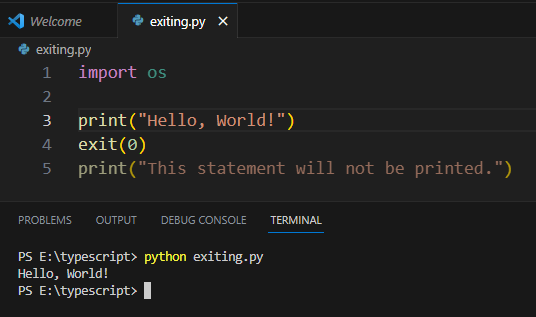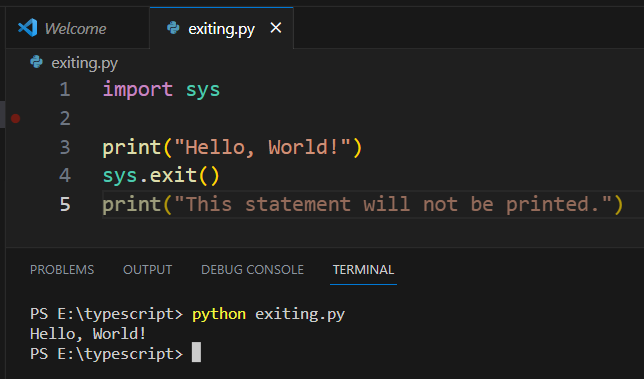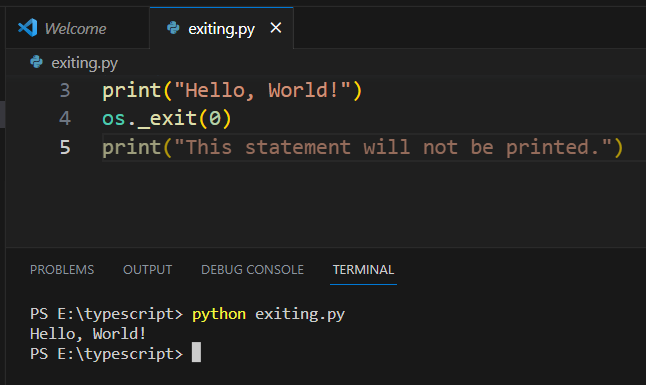When working with Python programs, understanding how to properly exit or terminate the program is a crucial skill. You’ll often run into cases where you’d want a swift exiting power over your program. Therefore, getting your hands dirty with some of the important exit methods in Python is important.
To exit a program in Python you can use the exit(), sys.exit(), or the os._exit() functions. For example, when the exit() function is called, it’ll terminate the execution of the program when a specific condition is met. Each method serves different needs, and the choice among them depends on your specific use case.

This article will explore three popular Python exit commands for exiting your applications. Understanding the nuances of each method and when to apply them can empower you to handle program termination more effectively in your Python journey.
Let’s get into it!
3 Ways to Exit Python Programs
Python is a versatile and user-friendly programming language that offers several methods for exiting a program.
In this section, we’ll look at three main ways you can use to exit a Python program: exit(), sys.exit(), and os._exit().

1. Using the exit() Function
The exit() function is a simple and straightforward way to terminate a Python program.
This function raises the SystemExit exception behind the scenes. When this exception is not caught, the function exits and stops the execution of the program.
exit() is more suitable for use in the interactive Python shell to stop issues like an infinite while loop and should ideally not be used in production scripts.
The following Python code is an example of exiting a program with the exit() function:
print("Hello, World!")
exit()
print("This statement will not be printed")In the above Python scripts, the string “Hello, World!” will be printed, but the “This statement will not be printed” line will not be executed because the exit() function will have already terminated the program running on the Python file.

2. Using the sys.exit()
The sys.exit() function also terminates a Python program. It’s similar to exit(), but more suited for use in production code.
This is because sys.exit() is part of the sys module, a site module that provides access to some variables used or maintained by the Python interpreter.
sys.exit() also raises the SystemExit exception, and if not caught, it’ll lead to program termination.
import sys
print("Hello, World!")
sys.exit()
print("This statement will not be printed.")Like the exit() function, the sys.exit() function also stops the execution of the program before the last print statement can be executed.

One of the unique features of sys.exit() is that you can pass an argument (typically an integer or a string) that denotes an exit status. Zero or None (which is the default value) implies a successful termination, and any other value (usually 1) indicates an abnormal termination.
import sys
try:
# Some code block
sys.exit(1)
except SystemExit as e:
print("Exit code", e)The end Python scripts will output the following:

3. Using the os._exit()
The os._exit() function is a little different from the previous two functions. It comes from the os module, which provides a way of using operating system-dependent functionality.
Unlike exit() and sys.exit(), os._exit() does not raise an exception or call cleanup handlers; instead, it ends the process directly. Because it’s a low-level, abrupt way to exit the Python interpreter, it doesn’t ensure proper cleanup of resources or flushing stdio buffers.
Therefore, it should only be used in a child process or when it’s absolutely necessary to make a clean exit immediately.
import os
print("Hello, World!")
os._exit(0)
print("This statement will not be printed.")The exit message print will be:

The argument to the os module exit function is a specified status code to pass to the operating system, with zero usually indicating the program terminates without issue.
import os
try:
# Some code block
os._exit(1)
except:
print("This statement will not be printed.")In the above code, no exception is raised by os._exit(), and hence the except block will not be executed. This demonstrates the immediate exit program effect of os._exit() without calling cleanup handlers, flushing stdio buffers, etc.
All three of these functions provide ways to exit Python programs, each with its own characteristics and suitable use cases. Depending on your specific needs, one function may be more appropriate than the others.
In general, sys.exit() is the most widely used and should be your go-to for most applications.
What is the Difference Between Exit() and Quit() Functions?
You might also have come across the popular Python’s in-built quit() function in Python and might be wondering how it’s different than the exit() function.
In this section, we’ll look at the difference between quit() and exit() functions in Python.

In Python, you can use two different functions to exit a program: exit() and quit(). Both functions are used to terminate a Python program, but they’re designed for different purposes.
exit() is an in-built function that’s part of the sys module and is the most commonly used function for end-program purposes. It takes an optional argument, the exit code, which defaults to 0 indicating a successful termination.
To use exit(), you need to import the sys module:
import sys
sys.exit()On the other hand, quit() is part of the Python standard library functions and is designed to be used in an interactive environment, such as a Python shell or an interpreter session.
It’s not recommended for use in scripts, as it can cause problems when used inside a try-except block. To use quit(), you simply call it without importing any modules:
quit()Choosing Exit() or Quit() Based on Environment
When deciding whether to use exit() or quit() in your Python program, it’s crucial to consider the programming environment:
- Scripts and production code: If you’re writing a Python script or developing production code, it’s better to use sys.exit() because it’s specifically designed to be used in a programmatic context. sys.exit() also allows you to provide an exit status, which can be helpful to debug or prevent Python program overflow.
- Interactive environment: If you’re working in an interactive Python environment such as a Python shell or an interpreter session, using quit() is more appropriate. In these cases, it’s designed for user convenience, allowing them to quickly exit the session.
To learn more tips about Python, check out the following video:
Final Thoughts
Understanding how to exit a Python program is important to your coding journey. It allows you to manage your program’s lifecycle efficiently and control when and how your applications terminate. This is crucial, especially when you’re dealing with system-critical applications, or those that require precise resource allocation.
Knowing these exit methods also allows you to handle unexpected situations or errors. Instead of letting your program crash, you can exit it programmatically, leaving useful information about what happened. This makes debugging a much smoother process.
Furthermore, different exit functions have different characteristics, making them suitable for various scenarios. By learning about them, you can choose the one that best fits your needs, elevating the sophistication and control of your programs.
Frequently Asked Questions

How do I close a program in the middle of execution?
To close a Python program in the middle of its execution, you can use the exit() or quit() functions.
For example:
import sys
if condition_met:
sys.exit()Alternatively, in a terminal, you can use the Ctrl + Z command in Windows or Ctrl + D in macOS to force the program to exit and make sure the script ends.
What is the difference between exit() and quit() in Python?
In Python, exit() and quit() serve the same purpose of terminating the program. However, exit() is a part of the sys module, whereas quit() is a function provided by the Python interpreter at the top level.
Generally, it’s recommended to use sys.exit() for scripting purposes and quit() when using the Python interactive shell.
Why isn’t sys.exit() working as expected?
If sys.exit() isn’t working as expected, it might be due to an exception being caught by a try–except block surrounding the sys.exit() call.
When sys.exit() is called, it raises a SystemExit exception, which can be caught by the except block.
To handle this, you can modify your except block to properly handle the SystemExit exception:
import sys
try:
sys.exit()
except SystemExit:
print("Exiting the program...")
raise
This will allow the program to exit gracefully while still handling other exceptions as required.
What are common sys.exit() exit codes?
Exit codes are integers that provide information about the reason a program is terminated.
By convention, an exit code of 0 indicates the program completed successfully, while non-zero exit codes indicate errors.
Some common exit codes are:
- 0: Success
- 1: General error or unspecified error
- 2: Incorrect command-line usage
- 3: External dependency failure (e.g., a required file is missing)
When calling sys.exit(), you can pass an exit code as an argument to indicate the reason for termination.
How do I import sys.exit for use in a Python script?
To import sys.exit for use in a Python script, you need to import the sys module. Add the following line at the beginning of your script:
import sysAfter importing the sys module, you can use the sys.exit() function to terminate your script when required.








